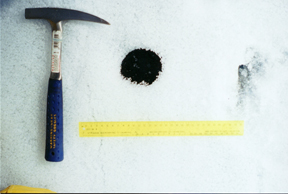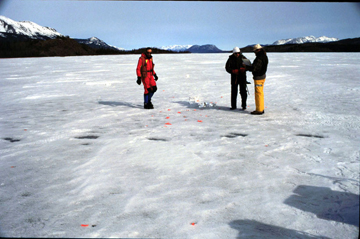|
Web Extra Monday, December 4, 2006 updated Dec. 6
Meteorite pre-dates solar system
When the Tagish Lake meteorite crashed to Earth six years ago, researchers
suspected that it could provide one more clue to the origin of life, but
instruments were not yet sophisticated enough to confirm a connection.
That connection could soon turn up, as a team of NASA researchers recently
reported finding organic material in the meteorite fragments that pre-dates
the solar system.
 Researchers
have long speculated that comets and meteorites could have brought the
basic ingredients of life to ancient Earth, especially some important
simple organic molecules such as amino acids. Organic materials, such
as those found by the NASA team, might have played some role in the pre-biotic
development of early life, the team reported Dec. 1 in Science.
"We may be one step closer to knowing where our ancestors came from,"
says Keiko Nakamura-Messenger of NASA's Johnson Space Center, and lead
author of the new study.
Researchers
have long speculated that comets and meteorites could have brought the
basic ingredients of life to ancient Earth, especially some important
simple organic molecules such as amino acids. Organic materials, such
as those found by the NASA team, might have played some role in the pre-biotic
development of early life, the team reported Dec. 1 in Science.
"We may be one step closer to knowing where our ancestors came from,"
says Keiko Nakamura-Messenger of NASA's Johnson Space Center, and lead
author of the new study.
The Tagish
Lake meteorite — the black rock shown at right, next to the hammer
for scale
— crash-landed on the
frozen British Columbia lake in 2000. New research suggests that the meteorite
pre-dates our solar system. Images are copyright of the University
of Western Ontario and the University of Calgary.
The meteorite, which landed in British Columbia in 2000, contains tiny
hollow globules whose carbon-rich shells may have been containers for
early organic molecules. Although the existence of globules is not news
— they were recognized several years ago — it wasn't until last
year that NASA had instruments powerful enough to analyze the globules'
nanometer-thin walls, and until now, their composition and origin remained
unknown.
The team's recent analysis revealed that the isotopic signature of these
walls, or rinds, is very different from what we find in our solar system.
The rinds are composed largely of carbon, but also contain hydrogen, nitrogen
and deuterium. Their unusual isotopic signature "immediately identifies
this material as not being of solar system origin," says Peter Brown,
a meteor physicist at the University of Western Ontario, who co-authored
the first Tagish Lake meteorite Science paper in 2000. "It's
not homogenized with the rest of the isotopic soup of the early solar
system," he says.
"If you started sampling birds, and trees, and people, and organic
slime at the bottom of the ocean, you would get a certain range of carbon,
hydrogen and nitrogen ratios," says Alan Hildebrand, a planetary
scientist at the University of Calgary, and a co-author on the 2000 Science
paper. "And that's all you would find, so the fact that [Tagish has]
different isotope ratios tells us that the material came from somewhere
else: It can't be terrestrial in origin."
Indeed, Nakamura-Messenger's team's research on isotopic ratios showed
that the globules formed at about negative 260 degrees Celsius, near absolute
zero. Such extreme conditions have never occurred on Earth or anywhere
in its neighborhood in the history of the solar system, Nakamura-Messenger
says. For this reason, she suggests that the meteorite's material originated
either in the Kuiper Belt — the family of bodies orbiting beyond
Neptune — or more likely, in the molecular dust cloud that would
later collapse to form the solar system.
But how that organic material came to exist on a meteorite on Earth is
another question. Scientists suggest that when ice grains in molecular
clouds get close to a young, hot star, the star's ultraviolet radiation
changes the ice into an organic substance. During solar system formation,
the globules were incorporated into small structures, which then stuck
together to form asteroids, planets and in some cases, the rocks that
would eventually crash to Earth as meteorites.
 "Knowing
now where things fit in, that's exciting," Brown says, "because
previously people didn't known whether this organic material was created
in the asteroid itself." These structures, he says, "are clearly
not formed in situ in the asteroid."
"Knowing
now where things fit in, that's exciting," Brown says, "because
previously people didn't known whether this organic material was created
in the asteroid itself." These structures, he says, "are clearly
not formed in situ in the asteroid."
After collecting fragments of a
meteorite that crashed to Earth on the frozen Tagish Lake in British Columbia
in 2000, researchers have been working to analyze the meteorite.
Brown was alerted to the meteorite's existence in 2000 by the Department
of Defense's space-based sensors, which detected the shower of fireballs.
Usually, meteorites come in over the Pacific and are lost in the ocean,
he says, but this one crash-landed on the frozen Tagish Lake. Jim Brook,
a local resident, collected many fragments in plastic bags, careful to
avoid contamination, and kept them frozen.
"The nice thing about Tagish Lake is that there is a lot of pristine
material," Brown says. Tagish is "the sort of material that
would have bombarded the early Earth with great frequency," possibly
setting the stage for the development of life.
The same is probably true of most planetary systems in our galaxy, however,
Hildebrand says. "Organic does not mean produced by life, but just
containing carbon, hydrogen, oxygen and nitrogen." Life on Earth
is carbon based, but carbon exists throughout the atmosphere, he says.
"I think [the team's] work is very significant, but I think the origin
of life thing is hyped," he says. The real significance of the recent
findings, he says, is the insight they provide into the chemical processes
inside molecular clouds. "It's quite exciting that they've been able
to show that these components are pre-solar and infer their place of origin."
Sally Adee
Geotimes contributing writer
Links:
"Reflections on the Tagish
Lake meteorite," Geotimes, November 2001
"Peeking into planetary past,"
Geotimes, November 2000
NASA site about the meteorite
University
of Calgary, University of Western Ontario information about the meteorite
Back to top

 Subscribe
Subscribe

